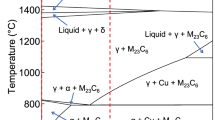Abstract
High temperature exposure of dissimilar ferritic steel weldments either during service or during post weld heat treatment has been found to result in the formation of deleterious ‘hard’ and ‘soft’ zones near the weld interface. Activity gradient driven carbon diffusion was found to be responsible for the formation of the zones. One of the methods suggested for suppression of the zone formation is by use of carbon diffusion barriers. The effectiveness of this method was investigated in this study using numerical simulations based on finite difference method. Diffusion barriers like copper, cobalt and nickel were evaluated for this purpose due to their positive interaction parameter, ɛ MC with carbon. It was found that these interlayers if introduced between 9Cr-1Mo and 2¼Cr-1Mo ferritic steels reduce the propensity for formation of hard and soft zones. It was found by computation that their efficiency correlates well with the differences in interaction parameter with carbon.
Similar content being viewed by others
References
Kim B C, Song J T, and Ann H S, in Proc International trends in Welding Science and Technology, (eds) David S A and Vitek J M, ASM International, Materials Park, Ohio (1992) 307.
Huang M L, and Wang L, Metall Trans, 29A (1998) 3037.
Buchmayr B, Fundamentals and applications of ternary diffusion, Pergamon press, New York (1990) p 164.
Sudha C, Terrance A L E, Albert S K, and Vijayalakshmi M, J Nucl Mater, 302 (2002) 193.
Sudha C, Terrance A L E, and Vijayalakshmi M, in Proc IIW Asian Pacific International Congress, Welding Technology Institute of Australia, Singapore, (2002) p 1–15.
Goldstein J I, and Moren A E, Metall Trans, 9A (1978) 1515.
Crank J, The mathematics of diffusion, Oxford university press, Oxford (1956) p 156.
Birchenall C E, and Mehl R F, Trans AIME, 171 (1947) 143.
Kucera J, and Stransky K, Mater Sci Eng, 52 (1982) 1.
Wada H, Metall Trans, 16A (1985) 1479.
Londolt and Bornstein, Diffusion in solids, metals and alloys, Springer Verlag, New York (1990) p 372.
E-Hsin Foo, and Lupis C H P, Acta Metall, 21 (1973) 1409.
Author information
Authors and Affiliations
Corresponding author
Rights and permissions
About this article
Cite this article
Anand, R., Sudha, C., Karthikeyan, T. et al. Metal interlayers to prevent ‘hard zone’ formation in dissimilar weldments of Cr-Mo steels — A comparison between Cu, Co and Ni. Trans Indian Inst Met 61, 483–486 (2008). https://doi.org/10.1007/s12666-008-0055-9
Received:
Revised:
Published:
Issue Date:
DOI: https://doi.org/10.1007/s12666-008-0055-9




